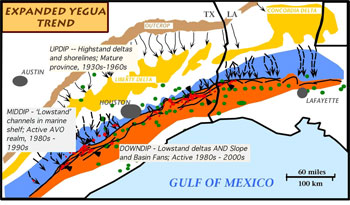Middle and Late Eocene Strata in the Northwestern Gulf of Mexico:
Sequence Stratigraphy, Structure and Hydrocarbons
By:
Thomas E. Ewing
Yegua Energy Associates
San Antonio, TX
| When: | Friday, February 11, 2011, 10:30 a.m. to 11:30 a.m. Join us for coffee beginning at 10:00 a.m. |
| Where: | Seminar Conference Room, 10100 Burnet Road, Bldg 196-ROC, Austin, Texas 78758 |
| Host: | Mead Allison, UTIG |

Abstract
The Middle and Late Eocene strata of the northern coastal plain of the Gulf of Mexico comprise 1500-3000m of marine to marginal-marine deposits. They provide a sensitive record of sea-level fluctuations, as well as a significant exploration target for oil, gas and coal.
The sequence is divided into four major genetic units (MGUs): the Queen City, Sparta, Yegua and Jackson, with minor extra units in the Reklaw (net-transgressive overlying the Upper Wilcox MGU) and the Weches (between the Queen City and Sparta).
The Queen City and Sparta units are well developed in portions of the Gulf area (Queen City in South Texas, and Sparta in Louisiana). Despite progradation to positions near the Wilcox paleo-shelf margin, neither unit shows clear evidence of significant lowstand events.
The Yegua unit was deposited during a time of greater clastic influx. It shows strong evidence for repeated fluctuations in relative sea level. Five to ten sequence boundaries can generally be correlated through the basin, but are most visible in areas of enhanced coarse-clastic deposition. In South Texas, lowstand systems tracts are generally attached, are composed of strike-oriented sand bodies, and are associated with only limited structuring. In East Texas and Louisiana, the Yegua exhibits incised valleys crossing an extensive sand-poor shelf; slumped and eroded shelf edges; localized shelf-edge deltas; complex growth faulting; and complex salt withdrawal relationships. Most of the complex sea level story is lost in the "classic" Alabama outcrops, which show a single sequence boundary.
The Jackson unit was deposited during a time of more limited clastic input. One major lowstand event ("Hockley") can be identified in South and East Texas, cutting across a regional barrier system. The entire Jackson interval, largely mud-rich in the middle shelf, becomes very thin in south Louisiana. The pattern, together with the thick muddy parasequences in Texas, suggests that a major "mud platform" is deposited around the shelf deltas.
The Yegua contains eight fairways of lowstand-related sedimentation, which have produced 3.4 TCFE from 334 fields. The greatest production is from fairways associated with the Liberty delta system and its flanks in Southeast Texas, as is well shown by production per mile of shelf margin. A secondary peak of production in South Texas is related to less permeable strandplain sands. Most production has come from incised valley systems and lowstand deltas at a faulted and slumped shelf margin; the slope and basin settings of the Yegua are a relatively unexplored frontier. Undiscovered reserves have been estimated (expected case) to exceed 4 TCF in the expanded fault-zone environment, and 8 TCF in slope and basin environments.




